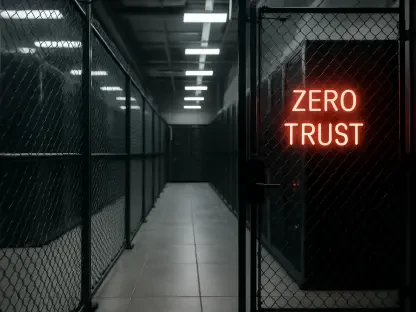Imagine a world where every click, search, and AI-generated response relies on a sprawling network of data centers consuming vast amounts of energy—facilities that power the digital economy yet strain global resources. As of this year, investments in these critical hubs have soared into the hundreds of billions, reflecting unprecedented demand driven by artificial intelligence and cloud computing. This roundup dives into the explosive growth of data centers, gathering insights from industry leaders, analysts, and sustainability experts to explore what fuels this boom, the challenges it faces, and the innovative solutions emerging worldwide. The purpose is to provide a comprehensive snapshot of diverse perspectives on how AI and green initiatives are reshaping this vital sector.
Unpacking the Surge: Key Drivers Behind Data Center Growth
AI’s Transformative Push: A Game-Changer for Infrastructure
Industry leaders across tech giants emphasize that artificial intelligence stands as the primary force propelling data center expansion. Hyperscale companies are funneling massive investments—think billions for AI-specific campuses in regions like Pennsylvania and Texas—into infrastructure to meet the computational hunger of machine learning models. Many note that the sheer scale of these projects signals a shift in how digital needs are prioritized, with AI workloads demanding unprecedented processing power.
Analysts, however, caution that this rapid growth strains existing facilities, pointing to management challenges in keeping pace with technology’s evolution. Reports of operational crises highlight a gap between current capacity and future requirements, sparking debates on whether supply can match AI’s relentless advancement. Some industry voices argue for modular, scalable designs as a potential fix to adapt more swiftly.
A contrasting view emerges from smaller tech firms, which stress that while AI drives demand, it also risks overshadowing other critical needs like cybersecurity infrastructure. They advocate for a balanced approach, ensuring that investments don’t solely cater to hyperscale giants but also support diverse digital ecosystems. This perspective underscores the complexity of aligning infrastructure with varied technological priorities.
Sustainability Pressures: Greening a Power-Hungry Industry
On the environmental front, sustainability experts applaud the industry’s pivot toward energy efficiency, spotlighting initiatives like major carbon-free hydroelectric agreements and innovative heat-repurposing projects in California. Such efforts are increasingly seen as standard, cutting both operational costs and emissions on a global scale. Many in the field view these green integrations as essential for public and regulatory acceptance of data center proliferation.
Yet, there’s a divide on feasibility, with some energy analysts warning of the tension between soaring power demands and environmental targets. They highlight that in energy-constrained regions, ambitious sustainability goals often clash with the reality of limited renewable resources. This friction raises questions about whether the industry can scale without compromising its green commitments.
A third angle comes from policy advocates who argue that regulatory frameworks must evolve to incentivize renewable adoption while addressing energy shortages. Their stance is that without stricter guidelines or innovative grid solutions, the push for sustainability might falter under the weight of unchecked expansion. This viewpoint calls for a collaborative effort between industry and government to bridge the gap.
Regional Shifts: Mapping the New Data Center Hotspots
Geographic diversification garners varied opinions, with market analysts identifying Asia-Pacific nations like Japan, Malaysia, and Thailand as rising stars due to strategic positioning and resource availability. They argue that these areas offer untapped potential, driven by digital adoption and favorable policies, positioning them as competitors to traditional markets. Southern Europe, too, gains attention for its subsea cable access and renewable energy prospects.
In contrast, North American industry watchers maintain that the U.S. retains dominance, citing mega-projects in Texas and Pennsylvania as evidence of unmatched scale and investment. However, they acknowledge setbacks in Europe, such as project cancellations in Dublin, as indicators of regional hesitations that could slow growth. This perspective suggests a fragmented global landscape where leadership isn’t guaranteed.
Emerging market proponents add another layer, emphasizing the Middle East and Africa as future hubs with significant investments in places like Nigeria and South Africa. They believe that while these regions lag in infrastructure, their strategic focus on digital hubs could redefine global data flows. This outlook challenges the notion that established markets will indefinitely hold sway, pointing to a broader redistribution of power.
Expansion Challenges: Obstacles on the Horizon
When it comes to barriers, energy consultants frequently cite supply shortages as a critical hurdle, noting that many regions struggle to provide the consistent power needed for sprawling data center campuses. Geopolitical uncertainties, including potential tariffs and trade disruptions, further complicate planning and investment. Their analysis warns of delays that could ripple across global projects if not addressed promptly.
Regulatory experts offer a different take, focusing on the complexities of compliance across diverse markets, particularly in Europe where hesitation contrasts with Asia-Pacific’s aggressive growth. They suggest that inconsistent policies create uneven playing fields, potentially stifling innovation in stricter jurisdictions. This viewpoint underscores the need for harmonized standards to facilitate expansion.
Economic forecasters, meanwhile, speculate on how broader shifts—such as inflation or currency fluctuations—might reshape investment priorities. Some predict that these factors could drive companies toward cost-effective emerging markets, while others see them as risks that might stall ambitious projects altogether. This debate highlights the delicate balance between opportunity and uncertainty in the industry’s trajectory.
Shaping Tomorrow: Core Insights from the Data Center Boom
Synthesizing these perspectives reveals a consensus on AI as an insatiable driver of data center demand, with sustainability emerging as a non-negotiable priority across the board. Experts agree that the race for strategic regional hubs is intensifying, though opinions differ on which areas will ultimately lead. While North America holds a strong position, Asia-Pacific and Southern Europe draw attention for their growth potential, creating a dynamic global competition.
Divergent views on challenges persist, with energy constraints and regulatory barriers seen as significant but surmountable through innovation and collaboration. Industry voices collectively stress the importance of renewable energy partnerships and modular infrastructure to address both environmental and scalability concerns. These strategies are viewed as critical to maintaining momentum without sacrificing responsibility.
A notable point of contention lies in prioritizing investments—whether to focus solely on AI-driven needs or diversify across other digital demands. This roundup reflects a broader industry dialogue on balancing cutting-edge technology with holistic growth, ensuring that data centers evolve as sustainable pillars of the digital economy rather than resource-draining giants.
Reflecting on the Roundup: Next Steps for the Industry
Looking back, this exploration of the data center boom uncovered a wealth of insights from varied corners of the industry, highlighting AI’s dominance, sustainability’s urgency, and the shifting geographic landscape. The discussions painted a picture of an industry at a crossroads, grappling with immense opportunity and equally daunting challenges. Diverse opinions converged on the need for strategic innovation to sustain growth.
Moving forward, stakeholders should consider prioritizing partnerships with renewable energy providers to tackle power demands head-on. Exploring modular and scalable designs could offer flexibility in rapidly changing markets, while advocacy for clearer, unified regulatory frameworks might ease expansion hurdles. These actionable steps provide a roadmap for navigating the complexities ahead.
Additionally, delving into emerging markets presents a chance to capitalize on cost-effective growth, potentially reshaping global data flows. Industry players are encouraged to keep abreast of regional trends and technological advancements, ensuring adaptability in an ever-evolving sector. This focus on proactive solutions aims to build a resilient foundation for the digital future.









